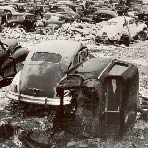
The Automobile and the Environment in American History
Introduction
The impact of the automobile and the auto-centered transport system on the American environment has been enormous. From the manufacturing process to the junkyard, cars—and all motorized vehicles for that matter—consume resources; pollute the air, land, and water; and transform space. The building of automobiles requires gathering vast quantities of metal, glass, plastics, rubber, and other materials, and then assembling thousands of vehicles through human and machine labor. The production process itself consumes enormous amounts of energy, and the factory output produces its own array of pollutants. Once on the road, automobiles are the prime consumers of oil and gas, stimulating increased drilling, transporting, and refining of petroleum products to meet the rising demand. Since the internal combustion engine continues to dominate automobile propulsion, cars dispense vast amounts of pollution in the form of air emissions, noise, used oil, and disposable parts. Derelict or scrapped vehicles pile up once automobiles end their productive lives. Beyond its role as polluter and artifact, the automobile has transformed the city and the countryside as much as or more than any technology designed by humans.
Despite its dramatic impact, the environmental history of the automobile is not easy to depict. Over the years, the car has been viewed as a benefactor as well as an environmental threat, as a boon to individualism, freedom, and liberation, and as the bane of modern society. By the turn of the twentieth century, what had been a technical curiosity, a rich man’s plaything, and a noise-belching menace to the nerves of humans and horses alike, began to gain acceptance. Enthusiasts touted the car as a practical,technically reliable means of conveyance that made scores of places more accessible; that was cheaper, easier to maintain, and longer-lived than an urban horse; and that would change the pattern and quality of city transportation for the better. To many people, the speed of the automobile on city streets did not seem any more dangerous than the speed of electric streetcars. Gas fumes seemed no worse than coal smoke from steam engines or manure from horses. Street sweepers praised the automobile for making their job easier: less manure to pick up and cart, fewer stables and manure pits, and not as many animal carcasses to dispose of.
There were, however, early critics of motorized vehicles. Some complained about the “car nuisance,” although they may have been referring to little more than reckless driving or the dust kicked up by autos as they rumbled down unpaved roads. Farmers became infuriated with urban car enthusiasts who gave little attention to frightening livestock or disturbing the tranquility of the countryside. Longer-term liabilities often were unforeseen at the time: accidents in excess of those on mass-transit systems; the economic, environmental, and social costs of supporting automobiles and their infrastructure; and ubiquitous smog.
By the time the car became the primary mode of personal transportation in the United States in the 1910s and 1920s, criticism grew harsher and more indicting despite the persistent boosting of its product by the automobile industry. Cars were blamed for most urban problems, including pollution, energy exploitation, congestion, scores of traffic fatalities, suburban sprawl, and the demise of downtowns. One critic referred to the automobile as “the greatest consumer of public and personal space yet created by man.” Another suggested that benefits of the automobile are “individualized for those who can afford them” while the costs are “shared by all, regardless of whether or not they can afford them.”
The gap between the critics and those who viewed the automobile as the most successful means of personal mobility yet devised created what some have called the “enigma of automobility” or the “automotive paradox.” From an environmental perspective, the impact of the automobile is no less complex and, in some cases, no less contradictory.
<<Previous Section - Next Section>>
Introduction
Environmental Cost of the Automobile Production Process
Energy Use and the Internal Combustion Engine
Auto Emissions and Air Pollution
Noise, Visual Pollution, and Derelict Cars
The Automobile's Imprint on the Landscape
Suburbanization and the Automobile
Conclusion
Complete Text Printable View
About the Project | Credits | Contact Us | Student & Teacher Resources | Site Map
©2004-2010 Automobile in American Life and Society

